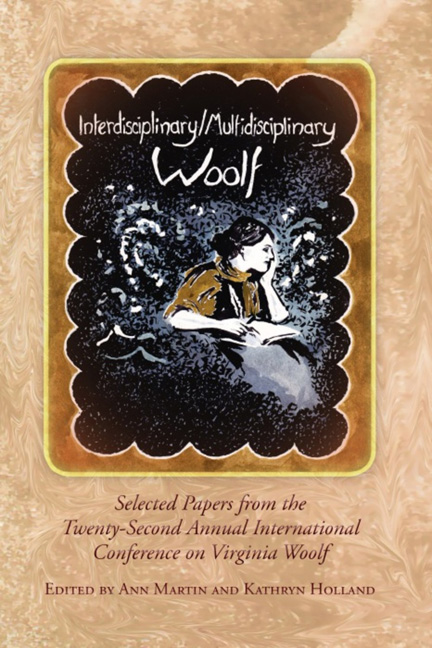Book contents
- Frontmatter
- Contents
- Introduction to Interdisciplinary/Multidisciplinary Woolf
- Acknowledgments
- List of Abbreviations
- History, Materiality, Multiplicity
- Multidisciplinary Woolf / Multiple Woolfs?
- Woolf, History, Us
- “Full of Experiments and Reforms”: Virginia Woolf, John Maynard Keynes, and the Impossibility of Economic Modeling
- Desiring Statues and Ambiguous Sexualities in Jacob's Room
- Challenging the Family Script: Woolf, the Stephen Family, and Victorian Evangelical Theology
- History as Scaffolding: Woolf's Use of The Times in The Years
- Vincent van Gogh, Virginia Woolf, and Old Shoes: A Cross-Cultural Iconography of Historical Truama from the Great War to the Iraq War
- Stopped at the Border: Virginia Woolf and the Criminalization of Dissent in Democratic Societies
- “Q. And babies? A. And babies”: On Pacifism, Visual Truama, and the Body Heap
- Photography, History, and Memoir of the Spanish Civil War: Interdisciplinary Views
- Patterns, Practices, Principles
- Art, Influence, Embodiment
- Publishing, Politics, Publics
- Notes on Contributors
- Conference Program
“Q. And babies? A. And babies”: On Pacifism, Visual Truama, and the Body Heap
from History, Materiality, Multiplicity
- Frontmatter
- Contents
- Introduction to Interdisciplinary/Multidisciplinary Woolf
- Acknowledgments
- List of Abbreviations
- History, Materiality, Multiplicity
- Multidisciplinary Woolf / Multiple Woolfs?
- Woolf, History, Us
- “Full of Experiments and Reforms”: Virginia Woolf, John Maynard Keynes, and the Impossibility of Economic Modeling
- Desiring Statues and Ambiguous Sexualities in Jacob's Room
- Challenging the Family Script: Woolf, the Stephen Family, and Victorian Evangelical Theology
- History as Scaffolding: Woolf's Use of The Times in The Years
- Vincent van Gogh, Virginia Woolf, and Old Shoes: A Cross-Cultural Iconography of Historical Truama from the Great War to the Iraq War
- Stopped at the Border: Virginia Woolf and the Criminalization of Dissent in Democratic Societies
- “Q. And babies? A. And babies”: On Pacifism, Visual Truama, and the Body Heap
- Photography, History, and Memoir of the Spanish Civil War: Interdisciplinary Views
- Patterns, Practices, Principles
- Art, Influence, Embodiment
- Publishing, Politics, Publics
- Notes on Contributors
- Conference Program
Summary
The image of the body heap in wartime—the gruesomely iconic pile of dead, frequently unarmed civilians—is thoroughly embedded in modern social consciousness, returning again and again as a kind of chorus to history's cacophonies. From Francisco Goya's early-nineteenth-century print series Disasters of War, to Carl Sandburg's 1918 poem “Grass,” to Ronald Haeberle's 1968 photographs of the My Lai massacre by U.S. soldiers in Vietnam, artists, writers, and photographers have repeatedly documented this scene, rarely pausing to debate whether it may ensure their perpetuation. In her 1938 work of radical feminist pacifism, Three Guineas, Virginia Woolf describes the experience of receiving photographs from the embattled Spanish Republic during its revolution and civil war, which “the Government sends with patient pertinacity about twice a week” (TG 14). The author writes,
They are photographs of dead bodies for the most part. This morning's collection contains the photograph of what might be a man's body, or a woman's; it is so mutilated that it might, on the other hand, be the body of a pig. But those certainly are dead children, and that undoubtedly is the section of a house.
Although Three Guineas ’ assertion centers on whether women can effectively align with men to end war if severe social, economic, and ideological inequalities exist between them, Woolf continually refers to these haunting photographs, these “dead bodies and ruined houses,” which act as almost the rising steam to her arguments’ pistons (see TG 14, 83, 167 et al.). Under the indiscriminately falling bombs of European fascism, Spanish men and women are not just dehumanized in their mass deaths, they become un-humanized into eviscerated animal clumps, while children eerily maintain compact familiarity even after being torn apart. The Republic selects and distributes these scenes of horror to enlist international aid and volunteers, while also forewarning what potential futures may unfold elsewhere without this urgently needed solidarity. Another Republican poster from the conflict portends, “if you tolerate this, your children will be next” (see Stradling).
And yet, Woolf doesn't include these images of atrocity in Three Guineas, which Jane Marcus suggests, in her 2006 introduction to the book, may have been out of the severe concern that it would incite people to further violence.
- Type
- Chapter
- Information
- Interdisciplinary/Multidisciplinary Woolf , pp. 68 - 72Publisher: Liverpool University PressPrint publication year: 2013



